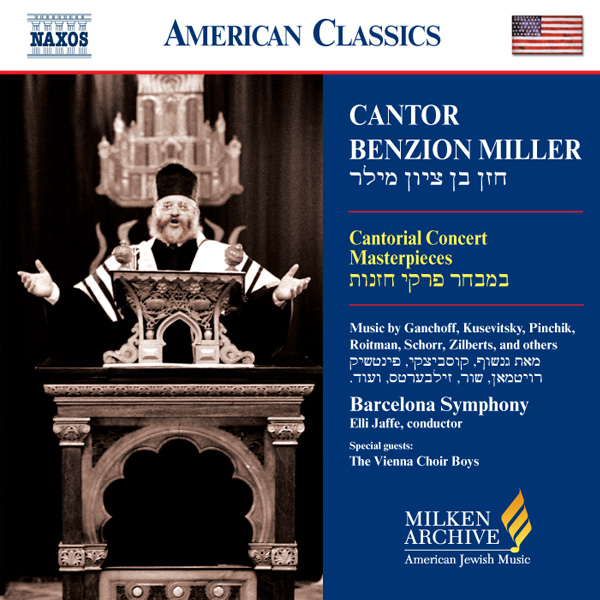
David Kusevitsky was the youngest of four world-renowned cantorial brothers; the other three were Moshe, Jacob, and Simcha. Each of the brothers was a unique and original artist, and each made significant contributions to the art of hazzanut. David’s own vocal style, in addition to its seemingly effortless virtuosity, was especially marked by refined elegance, graceful dignity, and warmth. In many ways he exemplified the 19th-century Viennese ideal, as established there by the architect of modern cantorial art, Salomon Sulzer, whose delivery possessed a profoundly emotional character fused with classical taste and musical intelligence. This synthesis also informed David Kusevitsky’s compositions.
Kusevitsky was born in Smorgon, now in Belarus, near the Lithuanian border. His father was an amateur violinist, and David’s own introduction to music making was on that instrument. After the First World War, the family moved to Vilna (Vilnius), where his brother Moshe became a boy chorister at the Vilna Khor Shul and eventually brought David there to sing as an alto. Later, when Moshe assumed a major cantorial post in Vilna, both Simcha and David sang in his choir. By the age of fourteen David had mastered the rudiments of music, apparently largely on his own, and he notated cantorial chants for Simcha when his older brother began officiating as a cantor.
David’s original interest lay primarily in conducting. Intending to become a choirmaster, he studied at the gymnasium in Vilna and at the local conservatory. When his brother Jacob was appointed to a cantorial pulpit in Lemberg (L’vov), Galicia, he brought David to direct the choir. And subsequently, when Simcha accepted a cantorial position in Rovno (Russian Poland, now Ukraine), David went there as well to become choirmaster. Following David’s service in the Polish army during the interwar years, where he also conducted a large chorus, Moshe, then a successful cantor in Warsaw, persuaded him to refocus on hazzanut rather than conducting. “You have a treasure in your voice,” Moshe was later quoted as advising, “so why work with your hands?” David studied voice in Warsaw and began officiating as a cantor at individual Sabbath services, but his formal debut as a solo cantor was in 1933–34 at the Philharmonic Hall in Łódź, where he was accompanied by a forty-voice choir.
At a concert performance in Hebrew of Haydn’s oratorio The Creation at the Tłomackie Synagogue in Warsaw, as part of an anniversary celebration for Hazzan Pinchas Sherman, Moshe sang the tenor role, and David performed the part of Gabriel, which was originally written for soprano. Although that synagogue was one of Europe’s leading liberalized khor shuls, female voices were considered religiously inappropriate and therefore unacceptable even for a nonliturgical concert. A review of the concert predicted a brilliant cantorial career for David, humorously observing that he “suffers from the ‘Koussevitzky disease’: he will one day be a major hazzan.” When his brother Simcha vacated the Rovno pulpit, David took his place as the chief cantor for three years, after which he went to London to serve as the cantor of the Hendon Synagogue. He remained in London throughout the Second World War, and he also lectured at Jews College there.
In 1948 Kusevitsky emigrated to America and became the cantor of Temple Emanu-El in the Boro Park section of Brooklyn, one of New York’s major Conservative movement synagogues at that time, where he served until his death, in 1985. From 1952 until his own death in 1966, his brother Moshe (who retained the earlier spelling of his name as Koussevitzky) was the cantor of the prestigious orthodox synagogue Temple Beth El of Boro Park, just around the corner. For a number of years, the annual Saturday midnight or postmidnight event that inaugurates the daily recitation of the penitential liturgy (S’liḥot) prior to Rosh Hashana (and between Rosh Hashana and Yom Kippur) with a formal, often musically elaborate choral service—known as “The First S’liḥot”—was timed by the two congregations in order to enable aficionados to hear both cantors in succession. Fans sometimes affectionately dubbed that marathon as “the annual S’liḥot doubleheader.”
In America, David Kusevitsky was presented with a world of concert opportunities not available to him in London, where the orthodox leadership (cantorial as well as rabbinic) at that time considered concert appearances inappropriate and religiously undignified for cantors as clergymen. A famous Carnegie Hall concert in New York featured all four brothers, in ensembles as well as solo renditions. One of David’s fourteen tours of Israel occurred just after the Six-Day War, in 1967, when he sang for Israeli soldiers on the banks of the Reed Sea (Red Sea) at Suez, performing a setting of the words from the liturgy—hamma’avir banav bein gizrei yam suf— that refer to the biblical account in Exodus of God’s splitting that sea for the ancient Israelites’ escape from Egypt.
Kusevitsky was also a dedicated teacher of hazzanut in New York—first at the Herzliah Institute and then for many years at the Cantors Institute (now the H. L. Miller Cantorial School) of the Jewish Theological Seminary, where he was able to influence many of today’s most accomplished cantors. His cantorial and choral compositions were written primarily for his own rendition, and many appear on his numerous recordings. Most of them remain in manuscript.
By: Neil W. Levin

